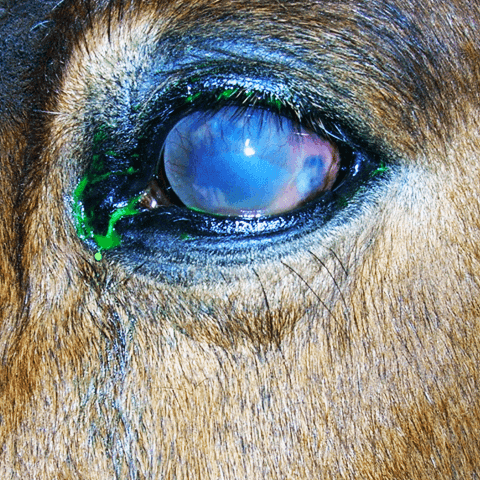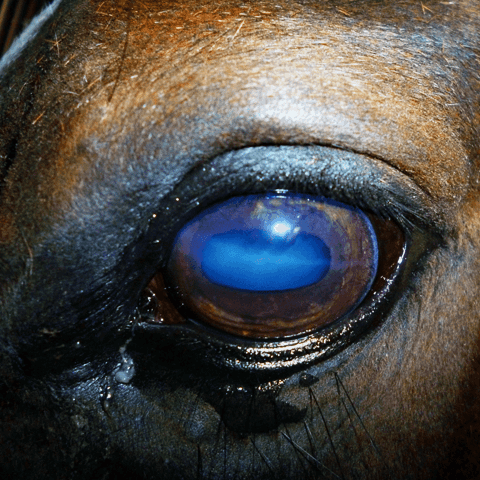You can get in touch with me by telephone or text during normal business hours, through the email form below, or by postal mail at the address listed below.
For emergencies, please call, do not use the contact form.
Contact
Contact Information
484-447-6945
P.O. Box 5011
Limerick, PA 19464
drjessvet.com
A Few Common Equine Eye Conditions
Injuries to the eye are one of the most common things we treat as equine veterinarians.
Posted on: February 3, 2014

Eye Conditions are Emergencies
Injuries to the eye are one of the most common things we treat as equine veterinarians. I always tell clients to treat eye conditions as emergencies and have them examined as soon as possible, because although eyes have amazing healing ability, they can also be permanently damaged in a very short period of time. Living outdoors, horses are exposed to all sorts of foreign bodies that can damage the eyes. Something as small as dust or sleet can cause irritation, as can pieces of hay, horses rubbing their faces on their legs, and sneaky things like the upturned edges of the handles on a water bucket. Other eye conditions can be brought on by viral or bacterial infections, auto-immune disorders, or for no obvious reason at all (we call this "iatrogenic"). In the absence of a veterinary exam, it is best to apply no medication to the eye, unless your veterinarian advises otherwise. Using the wrong medication (for example steroid ointment on an eye with a corneal ulcer) can lead to severe consequences such as permanent blindness.
Corneal ulcers are the most often seen eye condition in horses. Ulcerations to the surface of the cornea are started by direct trauma to the eye, such as a scratch from a foreign body such as hay or dirt. They may be very small or very large, and may involve only the most superficial layer of cells or penetrate dangerously close to the last layer of cells before the eye ruptures. Ulcers may also become infected with bacteria or fungus and complicate treatment and prognosis. Horse with corneal ulcers usually present suddenly with a teary, squinting eye and often swollen eyelids, but these signs are not specific to ulcerations and can be seen with many other eye conditions. You may also see a cloudy area on the surface of the cornea, called corneal edema. The main way we diagnose corneal ulcers is to apply fluorescein dye to the cornea. The dye will glow green and adhere to all but the deepest layers of cornea that have been damaged. This also helps us to determine how large the ulcer is to track its healing progress. We also check the size of the pupil on the damaged eye. Uncomfortable eyes will often have constricted pupils, and this muscle spasm in itself is painful. I usually treat ulcerated eyes with a topical antibiotic ointment to reduce the chance of infection while the eye heals itself, as well as atropine if the pupil needs to be dilated. A few doses of systemic anti- inflammatory such as Banamine usually make the horse a lot more comfortable. Uncomplicated ulcers usually heal within a week.

uveitis
This photo is of one of my patients who suffers from equine recurrent uveitis, during a flare-up. Note the green dye in the corner of her eye from when I stained her eye to check for ulcerations (there were none).
Anterior uveitis is the main differential diagnosis for the signs seen with a corneal ulcer, except there is no stain uptake. It is inflammation of the front portion of the eye, and can be secondary to something like an ulcer, or can be a primary condition as seen in recurrent equine uveitis (ERU or "night blindness"). Primary uveitis is an auto-immune condition, where the body basically attacks itself. This attack can be incited by small irritations like wind or dust, allergies, or systemic infections like Lyme's disease or Equine Herpes Virus (EHV/Rhino).
Most affected eyes show discomfort, some degree of corneal edema and constricted pupil, and may also have peripheral neovascularization (small blood vessels growing into the cornea from the edges of the eye) depending on how long it has gone on. In cases of Equine Recurrent Uveitis, the condition is chronic and will need to be managed for the duration of the life of the horse. The treatment for uveitis involves a dilating the pupil and systemic anti-inflammatories as for ulcers, but also usually a steroid drop or ointment for the affected eye. It is important to have eye conditions examined by a veterinarian who can prescribe the proper treatment, as treating an ulceration (as opposed to uveitis) with steroids could lead to an infection and potentially blindness. Depending on the situation, we may also use cyclosporine, an immune suppressant, for the eye. If we suspect an infection like Lyme's is the cause, we can test and treat for that as well. Advanced cases may progress to glaucoma or blindness in a short period of time, and may necessitate removal of the affected eye. This condition is more prevalent in Appaloosas than in other breeds.

band opacity
This is a neat photo of another patient's eye. The cloudy line running across the eye is called a 'band opacity', and it is a thinned area in the last layer of cells of the cornea (Descemet's membrane). This can be caused by trauma or inflammation within the eye.
Eyelid lacerations are probably the third most common eye problem seen in horses. Horses tend to put their heads where they shouldn't be, and even the most carefully tended barns have a sharp area somewhere. As I mentioned earlier, one place that tends to attract equine eyelids is water bucket handles. The upturned edges of the metal handles leave just enough space to insert an eyelid or nostril and cause injury on the way out. I use electrical tape wound tightly around mine to eliminate that potential space. Sometimes a horse just makes contact with a sharp board, a protruding nail, or the flashing covering the door.
If found within a few hours of injury, these lacerations can usually be successfully repaired, with some degree of difficulty! The best prognosis for a good cosmetic outcome is for a fresh laceration that has made a thick flap still attached to the rest of the eyelid. Thin flaps, older injuries, and completely severed areas make for a harder fix. It is always a nice surprise to see how my “cosmetic surgery” has turned out, especially when you can't tell the eyelid was ever damaged. There is not enough space in one blog to discuss all of the possible eye conditions that occur in horses, and they can be challenging to diagnose and treat, but I really enjoy working on them.